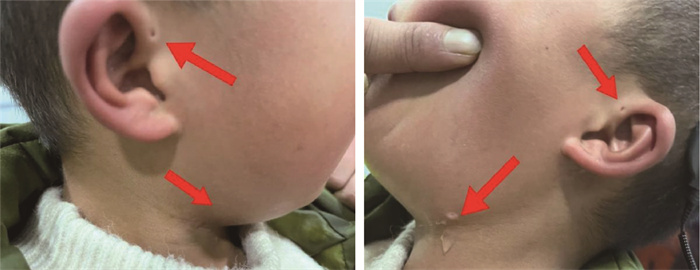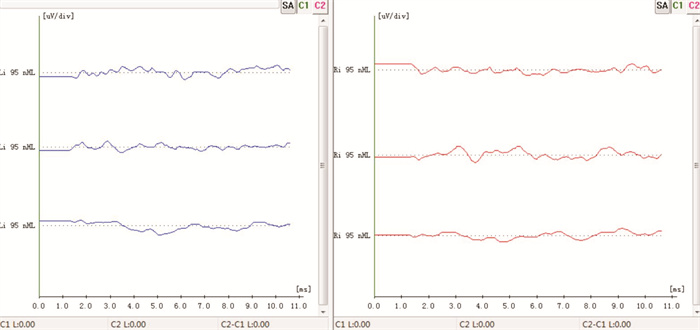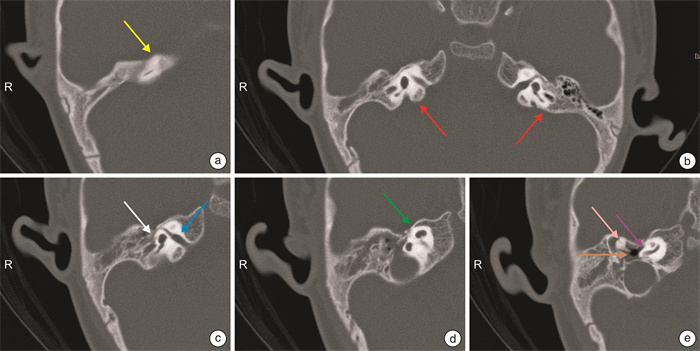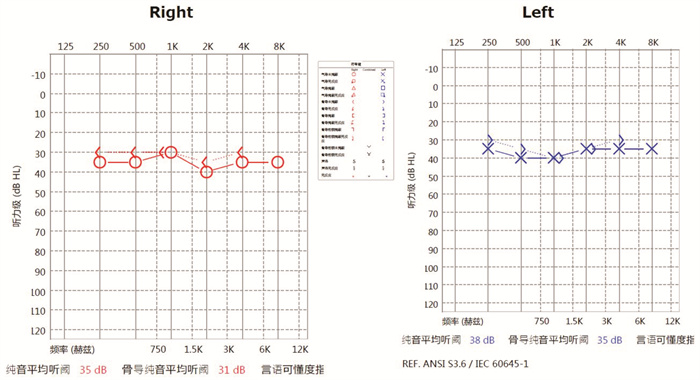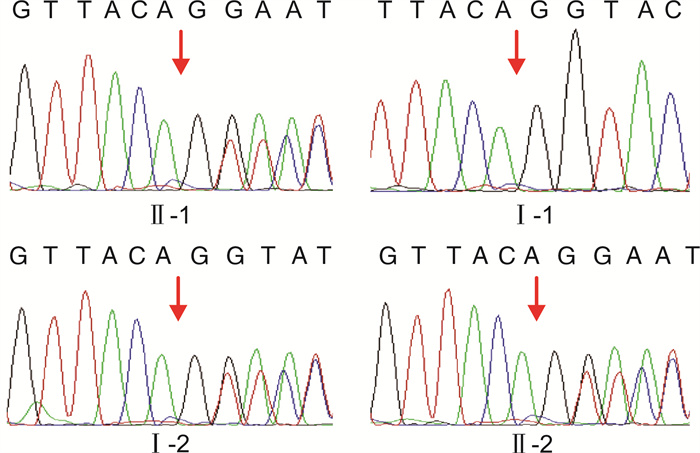Clinical phenotypic and genetic analysis of syndrome families with EYA1 gene variants
-
摘要: 目的 研究一个鳃耳综合征(branchio-oto syndrome)家系临床表型,探寻该家系的遗传学病因。方法 收集1例诊为鳃耳综合征的患儿及家系成员的临床资料,提取先证者及其家系成员的外周血基因组DNA,进行全外显子组测序,并对突变位点进行Sanger测序验证分析。结果 该家系包括2代4人,其中3人有表型,2人听力下降,并且有双侧耳前瘘管,双侧鳃裂瘘,1人双侧耳前瘘,双侧鳃裂瘘,均符合鳃耳综合征的临床诊断,该家系遗传方式为常染色体显性遗传,基因检测显示该家系所有发病成员 EYA1 基因均有c.1744delC(p.L592Cfs*47)变异,表型正常成员该位点为野生型,家系内符合基因型与表型共分离。该突变为移码突变,导致终止密码子提前出现,该突变目前尚未见报道。根据美国医学遗传学与基因组学学会指南,该变异初步判定为疑似致病性变异。结论 该家系新发现的EYA1c.1744delC(p.L592Cfs*47)突变为该家系患者的致病突变基因,进一步拓展了 EYA1 基因的突变谱,使我们对于该病有了更新的认识,为临床诊断和遗传咨询提供了重要参考。Abstract: Objective To investigate the clinical phenotype of a family with branchio-oto syndrome (BOS) and to explore the genetic etiology of the syndrome in this family.Methods Clinical data were collected from a child diagnosed with BOS and his family members. Genomic DNA was extracted from peripheral blood of the proband and his family members. Whole-exome sequencing was performed, and the mutation sites were verified and analyzed by Sanger sequencing.Results The family consists of two generations with four members, three of whom exhibit the phenotype. Two members have hearing loss and bilateral preauricular fistulas and bilateral branchial cleft fistulas. One member has bilateral preauricular fistulas and bilateral branchial cleft fistulas. All of which were in line with the clinical diagnosis of gill ear syndrome, the inheritance mode of the family was autosomal dominant inheritance, genetic testing showed that all members of the family had c. 1744delC(p. L592Cfs*47) mutation in the EYA1 gene, while unaffected members have the wild-type allele at this locus. This mutation is a frameshift mutation, which results in the early appearance of the stop codon, and has not been reported so far. According to ACMG guidelines, the variant was preliminarily determined to be suspected pathogenic.Conclusion The newly discovered EYA1c. 1744delC(p. L592Cfs*47) mutation in this family is the pathogenic mutant gene of the patients in this family, which further expands the mutation spectrum of EYA1 gene, gives us a new understanding of the disease, and provides an important reference for clinical diagnosis and genetic counseling.
-
Key words:
- branchio-oto syndrome /
- EYA1 gene /
- deafness /
- DNA mutation analysis
-

-
[1] 刘梦婷, 张天虹. 综合征性耳聋的诊断与治疗策略[J]. 临床耳鼻咽喉头颈外科杂志, 2021, 35(3): 285-288. doi: 10.13201/j.issn.2096-7993.2021.03.022
[2] Chen AH, Ling J, Peng X, et al. A novel EYA1 mutation causing alternative RNA splicing in a Chinese family with branchio-oto syndrome: implications for molecular diagnosis and clinical application[J]. Clin Exp Otorhinolaryngol, 2023, 16(4): 342-358. doi: 10.21053/ceo.2023.00668
[3] Melnick M, Bixler D, Nance WE, et al. Familial branchio-oto-renal dysplasia: a new addition to the branchial arch syndromes[J]. Clin Genet, 1976, 9(1): 25-34. doi: 10.1111/j.1399-0004.1976.tb01546.x
[4] Fraser FC, Sproule JR, Halal F. Frequency of the branchio-oto-renal(BOR)syndrome in children with profound hearing loss[J]. Am J Med Genet, 1980, 7(3): 341-349. doi: 10.1002/ajmg.1320070316
[5] 温莹莹, 孙宇, 孔维佳. 重视基因诊断在鳃耳肾综合征中的应用[J]. 临床耳鼻咽喉头颈外科杂志, 2018, 32(16): 1226-1231. doi: 10.13201/j.issn.1001-1781.2018.16.005
[6] Zheng H, Xu J, Wang Y, et al. Identification and characterization of a cryptic genomic deletion-insertion in EYA1 associated with branchio-otic syndrome[J]. Neural Plast, 2021, 2021: 5524381.
[7] 刘梦婷, 孟琦, 叶祎菁, 等. 鳃耳综合征家系EYA1基因一个新的无义突变[J]. 中华耳科学杂志, 2020, 18(5): 922-926. doi: 10.3969/j.issn.1672-2922.2020.05.022
[8] 李果, 林垦, 王翔, 等. 婴幼儿听性脑干反应、听性稳态反应、行为测听的相关性分析[J]. 中国听力语言康复科学杂志, 2020, 18(4): 295-298. doi: 10.3969/j.issn.1672-4933.2020.04.012
[9] Chang EH, Menezes M, Meyer NC, et al. Branchio-oto-renal syndrome: the mutation spectrum in EYA1 and its phenotypic consequences[J]. Hum Mutat, 2004, 23(6): 582-589. doi: 10.1002/humu.20048
[10] Feng HF, Xu HE, Chen B, et al. Genetic and phenotypic variability in Chinese patients with branchio-oto-renal or branchio-oto syndrome[J]. Front Genet, 2021, 12: 765433. doi: 10.3389/fgene.2021.765433
[11] Kemperman MH, Koch SM, Kumar S, et al. Evidence of progression and fluctuation of hearing impairment in branchio-oto-renal syndrome[J]. Int J Audiol, 2004, 43(9): 523-532. doi: 10.1080/14992020400050067
[12] Buller C, Xu X, Marquis V, et al. Molecular effects of Eya1 domain mutations causing organ defects in BOR syndrome[J]. Hum Mol Genet, 2001, 10(24): 2775-2781. doi: 10.1093/hmg/10.24.2775
[13] Han R, Xia Y, Liu ZJ, et al. A mutation of EYA1 gene in a Chinese Han family with Branchio-Oto syndrome[J]. Medicine, 2021, 100(25): e24691. doi: 10.1097/MD.0000000000024691
[14] Masuda M, Kanno A, Nara K, et al. Phenotype-genotype correlation in patients with typical and atypical branchio-oto-renal syndrome[J]. Sci Rep, 2022, 12(1): 969. doi: 10.1038/s41598-022-04885-w
[15] Li J, Zhao P, Xia Z, et al. Novel duplication mutation of EYA1 causes branchio-oto-renal syndrome in a Chinese family[J]. Lin Chuang Er Bi Yan Hou Tou Jing Wai Ke Za Zhi, 2021, 35(7): 607-612.
[16] Abdelhak S, Kalatzis V, Heilig R, et al. A human homologue of the Drosophila eyes absent gene underlies branchio-oto-renal(BOR)syndrome and identifies a novel gene family[J]. Nat Genet, 1997, 15(2): 157-164. doi: 10.1038/ng0297-157
[17] Lin ZL, Li J, Pei YX, et al. Misdiagnosed Branchio-Oto-Renal syndrome presenting as proteinuria and renal insufficiency with insidious signs since early childhood: a report of three cases[J]. BMC Nephrol, 2023, 24(1): 248. doi: 10.1186/s12882-023-03193-3
[18] 张致恺, 张燕梅, 宗亚静, 等. 耳聋相关基因诊断与遗传咨询的临床实践[J]. 临床耳鼻咽喉头颈外科杂志, 2019, 33(1): 58-62, 66. doi: 10.13201/j.issn.1001-1781.2019.01.012
[19] Masuda M, Kanno A, Nara K, et al. Phenotype-genotype correlation in patients with typical and atypical branchio-oto-renal syndrome[J]. Sci Rep, 2022, 12(1): 969. doi: 10.1038/s41598-022-04885-w
[20] Klingbeil KD, Greenland CM, Arslan S, et al. Novel EYA1 variants causing Branchio-oto-renal syndrome[J]. Int J Pediatr Otorhinolaryngol, 2017, 98: 59-63. doi: 10.1016/j.ijporl.2017.04.037
-

计量
- 文章访问数: 231
- 施引文献: 0



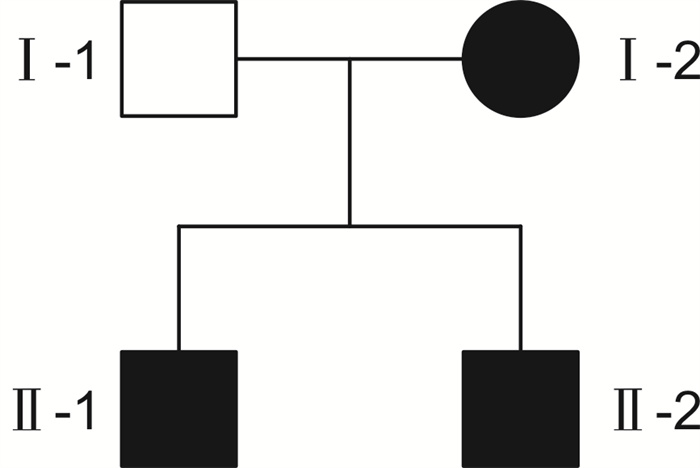
 下载:
下载:
